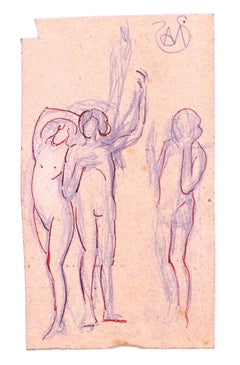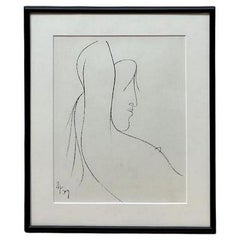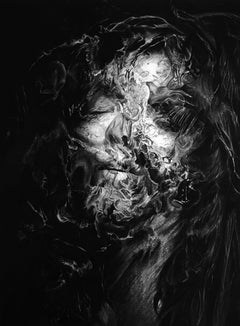Alexis Mérodack-Jeanneau Figurative Drawings and Watercolors
French, 1873-1919
Alexis Mérodack-Jeanneau was a French painter and sculptor, associated with the fauvist movement. He initiated the first Parisian exhibition of Vassily Kandinsky in 1904 and directed an art magazine open to the artistic avant-garde, The New Trends (1904–1914). He is associated with the Fauvist movement.
to
6
Overall Width
to
Overall Height
to
5
1
3
5
1
6
5
4
3
3
2
1
3
2
2
6
923
323
221
192
6
Artist: Alexis Mérodack-Jeanneau
Woman Portrait - Charcoal on Paper by A. Mérodack-Jeanneau
By Alexis Mérodack-Jeanneau
Located in Roma, IT
Woman Portrait is a superb charcoal drawing on ivory paper realized by Alexis Mérodack-Jeanneau in the early 20th century.
Stamp of the artist's atelier on the lower right corner of...
Category
Late 19th Century Alexis Mérodack-Jeanneau Figurative Drawings and Watercolors
Materials
Charcoal
Woman Standing Arms Raised - Ink and Pencil by Alexis Mérodack-Jeanneau
By Alexis Mérodack-Jeanneau
Located in Roma, IT
Woman standing arms raised is an ink and pencil drawing and red line on paper realized by Alexis Mérodack-Jeanneau in the early 20th century.
Hand-signed by the artist, on the top ...
Category
Early 20th Century Modern Alexis Mérodack-Jeanneau Figurative Drawings and Watercolors
Materials
Pencil, Ink
Portrait - Charcoal Drawing on Paper by A. Mérodack-Jeanneau
By Alexis Mérodack-Jeanneau
Located in Roma, IT
Portrait is an original drawing on ivory paper realized by Alexis Mérodack-Jeanneau in the early 20th century.
Stamp of the artist's atelier on the lower left corner of the paper.
...
Category
Late 19th Century Alexis Mérodack-Jeanneau Figurative Drawings and Watercolors
Materials
Charcoal
Woman with Umbrella - Charcoal Drawing on Paper by A. Mérodack-Jeanneau
By Alexis Mérodack-Jeanneau
Located in Roma, IT
Woman with Umbrella is an original drawing on ivory paper realized by Alexis Mérodack-Jeanneau in the early 20th century.
Stamp of the artist's at...
Category
Late 19th Century Alexis Mérodack-Jeanneau Figurative Drawings and Watercolors
Materials
Charcoal
Woman Bust - Pencil on Paper by A. Mérodack-Jeanneau
By Alexis Mérodack-Jeanneau
Located in Roma, IT
Woman Bust is a beautiful pencil drawing on ivory paper realized by Alexis Mérodack-Jeanneau in the early 20th century.
Stamp of the artist's atelier on the lower right corner of th...
Category
Late 19th Century Modern Alexis Mérodack-Jeanneau Figurative Drawings and Watercolors
Materials
Pencil
Nude Women - Ink Drawing on Paper by A. Mérodack-Jeanneau
By Alexis Mérodack-Jeanneau
Located in Roma, IT
Nude Women is an original artwork realized between the XIX and the XX century by Alexis Mérodack-Jeanneau
Original mixed colored pencil drawing on paper.
Stamp of the artist's ate...
Category
Late 19th Century Modern Alexis Mérodack-Jeanneau Figurative Drawings and Watercolors
Materials
Ink
Related Items
Nude Woman Profile Drawing by Radoczy
By Albert Radoczy
Located in Pasadena, CA
Reclining Female figure, original signed line drawing, in pencil and ink by Albert Radoczy.
Albert Radoczy was a master at exploring the female form. Throughout his career, his draw...
Category
1950s Modern Alexis Mérodack-Jeanneau Figurative Drawings and Watercolors
Materials
Ink, Pencil
$304 Sale Price
20% Off
H 14.38 in W 11.88 in D 0.88 in
Nebulous
By Tricia Butski
Located in Buffalo, NY
Through drawings rendered in charcoal and ink, my recent work examines issues related to memory by exploring its limitations and aestheticizing the instability inherent in portraitur...
Category
2010s Photorealist Alexis Mérodack-Jeanneau Figurative Drawings and Watercolors
Materials
Charcoal, Paper
"Contemplation"
By Gershon Benjamin
Located in Lambertville, NJ
Jim’s of Lambertville is proud to offer this artwork by:
Gershon Benjamin (1899-1985)
An American Modernist of portraits, landscapes, still lives, and the urban scene, Gershon Benj...
Category
1920s Modern Alexis Mérodack-Jeanneau Figurative Drawings and Watercolors
Materials
Graphite
Mark Beard 054 (Figurative Charcoal Drawing of Two Male Nudes on Arches Paper)
By Mark Beard
Located in Hudson, NY
Figurative drawing of two male nudes made with graphite, charcoal, and conte crayon on Arches paper
30 x 14 inches, unframed
This unique life study drawing of two standing nude m...
Category
2010s Modern Alexis Mérodack-Jeanneau Figurative Drawings and Watercolors
Materials
Charcoal, Graphite, Paper
MB 807 (Figurative Charcoal Drawing on Arches Paper of Two Male Nude Models)
By Mark Beard
Located in Hudson, NY
Figurative drawing of two male nudes made with graphite, conte crayon and charcoal on Arches paper
30 x 18.5 inches, unframed
This unique life study drawing of two standing male n...
Category
2010s Modern Alexis Mérodack-Jeanneau Figurative Drawings and Watercolors
Materials
Archival Paper, Charcoal, Graphite
$1,600
H 30 in W 18.5 in
MB 076 A&B (Double Sided Figurative Charcoal Drawing of Male Nudes)
By Mark Beard
Located in Hudson, NY
Figurative drawing of male nudes made with graphite, charcoal, and conte crayon on Arches paper
30 x 22 inches, unframed
One piece of 30 x 22 inch Arches. Two drawings, one on either...
Category
Early 2000s Modern Alexis Mérodack-Jeanneau Figurative Drawings and Watercolors
Materials
Charcoal, Archival Paper, Graphite
$1,600
H 30 in W 22 in
MB 806 (Figurative Charcoal Drawing on Paper of Two Muscular Male Nudes)
By Mark Beard
Located in Hudson, NY
Figurative nude drawing made with graphite, conte crayon and charcoal on Arches paper
30 x 19 inches unframed
This unique life study drawing of two male nude models was made by Mark...
Category
2010s Modern Alexis Mérodack-Jeanneau Figurative Drawings and Watercolors
Materials
Archival Paper, Charcoal, Graphite
MB 001 (Modern, Academic Style Figurative Life Drawing of Muscular Male Nude )
By Mark Beard
Located in Hudson, NY
Figurative male nude drawing on Arches paper by Mark Beard
graphite, conte crayon and charcoal on Arches paper
22 x 15 inches unframed
Contemporary figurative life study drawing of ...
Category
2010s Modern Alexis Mérodack-Jeanneau Figurative Drawings and Watercolors
Materials
Conté, Graphite
Young man in a toga elegant man Latin American hyperrealist Hockney style
By Claudio Bravo
Located in Norwich, GB
Superb original drawing in coloured conté pencils, heightened with white on oatmeal coloured vergé paper by Claudio Bravo. The work was created during the artist's Moroccan period, a...
Category
1970s Modern Alexis Mérodack-Jeanneau Figurative Drawings and Watercolors
Materials
Conté, Laid Paper, Color Pencil
$7,500
H 30.32 in W 24.02 in D 0.4 in
A Handsome 1940s Portrait of a Seated Man by Chicago Artist, Harold Haydon
By Harold Haydon
Located in Chicago, IL
A Handsome 1940s Portrait of a Seated Man by Chicago Modern Artist, Harold Haydon (Am. 1909-1994). A wonderfully executed line drawing dating from 1946 with great character; looks ...
Category
Mid-20th Century American Modern Alexis Mérodack-Jeanneau Figurative Drawings and Watercolors
Materials
Paper, Graphite
$135
H 20 in W 16 in D 0.13 in
MB 804 A&B (Double Sided Figurative Drawing, Two Male Nudes and Safari Hunter)
By Mark Beard
Located in Hudson, NY
Figurative drawing with graphite, charcoal, and conte crayon on Arches paper
30 x 19 inches, unframed
One piece of 30 x 19 inch Arches paper. Two drawings on opposite sides.
These u...
Category
2010s Modern Alexis Mérodack-Jeanneau Figurative Drawings and Watercolors
Materials
Archival Paper, Charcoal, Graphite, Watercolor
SLICED VENUS - original large art by Paula Craioveanu 30x27in Neo Mythology
By Paula Craioveanu
Located in Forest Hills, NY
Sliced Venus. Original art, signed 100x70cm / 30x27in, ink, graphite, tempera on paper. large size, shipped rolled in a tube
Drawing has on the back 2 white wood sticks, and it's rea...
Category
2010s Contemporary Alexis Mérodack-Jeanneau Figurative Drawings and Watercolors
Materials
Tempera, Pencil, Ink, Archival Paper
$480 Sale Price
20% Off
H 39 in W 27.5 in
Previously Available Items
The Bride - Pencil and Charcoal Drawing on Paper by A. Mérodack-Jeanneau
By Alexis Mérodack-Jeanneau
Located in Roma, IT
The Bride is a splendid artwork realized by Alexis Mérodack-Jeanneau in the early 20th century.
Charcoal and pencil drawing on ivory paper. Stamp of the artist's atelier on the lowe...
Category
Late 19th Century Modern Alexis Mérodack-Jeanneau Figurative Drawings and Watercolors
Materials
Pencil, Charcoal
H 6.11 in W 4.73 in D 0.08 in
Man Seen From Behind - Charcoal on Paper by A. Mérodack-Jeanneau
By Alexis Mérodack-Jeanneau
Located in Roma, IT
Man Seen From Behind is an original charcoal drawing on ivory paper realized by Alexis Mérodack-Jeanneau in the early 20th century.
Stamp of the arti...
Category
Late 19th Century Modern Alexis Mérodack-Jeanneau Figurative Drawings and Watercolors
Materials
Charcoal
H 6.11 in W 3.55 in D 0.08 in
Holy Family - Ink Drawing on Paper by A Mérodack-Jeanneau
By Alexis Mérodack-Jeanneau
Located in Roma, IT
Holy Family is an original artwork realized between the XIX and the XX century by Alexis Mérodack-Jeanneau
Original black and white drawing on paper.
Stamp of the artist's atelier...
Category
Late 19th Century Alexis Mérodack-Jeanneau Figurative Drawings and Watercolors
Materials
Ink
Alexis Mérodack-JeanneauHoly Family - Ink Drawing on Paper by A Mérodack-Jeanneau, late 19th Century
H 5.32 in W 4.38 in D 0.08 in
Alexis Mérodack-jeanneau figurative drawings and watercolors for sale on 1stDibs.
Find a wide variety of authentic Alexis Mérodack-Jeanneau figurative drawings and watercolors available for sale on 1stDibs. If you’re browsing the collection of figurative drawings and watercolors to introduce a pop of color in a neutral corner of your living room or bedroom, you can find work that includes elements of orange and other colors. You can also browse by medium to find art by Alexis Mérodack-Jeanneau in charcoal, ink, pencil and more. Much of the original work by this artist or collective was created during the 19th century and is mostly associated with the modern style. Not every interior allows for large Alexis Mérodack-Jeanneau figurative drawings and watercolors, so small editions measuring 4 inches across are available. Customers who are interested in this artist might also find the work of Ernest Rouart, Georges Antoine Rochegrosse, and Buscot. Alexis Mérodack-Jeanneau figurative drawings and watercolors prices can differ depending upon medium, time period and other attributes. On 1stDibs, the price for these items starts at $279 and tops out at $468, while the average work can sell for $357.


